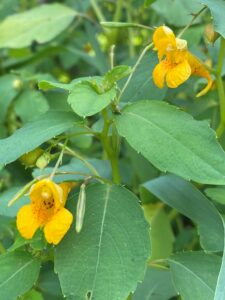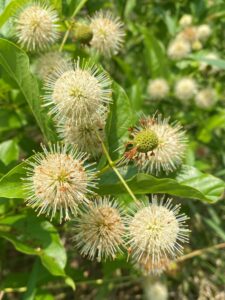Nine Native Blooms To Look For in July
article and photos by Drew Granville, Volunteer Botanist at Fontenelle Forest
Lately, we’ve been talking a lot about wildflowers because this is prime wildflower viewing season! Fostering the growth of native plants (and eradicating non-native species) is an important part of the conservation work done by Fontenelle Forest’s Land Stewardship team.
So, we get excited when we see native plants thriving – and we want to get you excited about it too. In this blog, we are focusing on nine native blooms you can look for in July at Fontenelle Forest and Neale Woods. Although fewer plants may be blooming in the oak woodlands during the month of July, a large variety of diverse plant life can be seen thriving in wetlands and prairies. Not only is this true for Fontenelle Forest and Neale Woods, but across eastern Nebraska as well as the summer progresses.
Woodlands
American lopseed is an uncommon find that sometimes occurs along the wooded trails at Fontenelle Forest and Neale Woods. Look for erect plants with small, spreading white flowers and pinkish-purple markings.
As restoration efforts continue, sightings of the Mullein foxglove are increasing at Neale Woods. This wildflower has small, yellow, tubular bell-shaped flowers. It is parasitic to oak tree roots (meaning they attach to the roots of oak trees and suck moisture from them) but also relies on sunlight. It is most often seen in open, wooded areas on the Neale Woods property.
Eastern figwort is another wildflower found in the woodlands. This is a tall plant with small, brownish-purple flowers that are green-tinged on the outside. It can be seen growing near woodland trails at both Fontenelle Forest and Neale Woods.
- American lopseed
- Mullein foxglove
- Eastern figwort
Floodplains
If you’re hiking along Hidden Lake Trail at Fontenelle Forest or near the Missouri River shore, keep an eye out for “monkeys,” otherwise known as Allegheny monkeyflowers. These blue and lavender flowers can resemble a monkey’s face!
Despite its name, the spotted jewelweed is a native North American wildflower. It is abundant in the shaded wetlands of Fontenelle Forest’s floodplain. To find the spotted jewelweed, look for plants with orange or red irregular flowers in marshy areas.
While hiking through the southern floodplains of Fontenelle Forest, look for a shrub with white, ball-like flowers called a buttonbush. Rangers at Fontenelle Forest have seen these shrubs swarming with native pollinators.
- Allegheny monkeyflower
- Spotted jewelweed
- Buttonbush
Prairies
Virginia mountain mint is a common prairie plant often found at Jonas Prairie at Neale Woods. Look for medium-height plants with clusters of white flowers and purplish spots.
The compass plant is a tall, yellow sunflower with fern-like basal leaves that tend to face north and south to minimize exposure to the harsh sun. It can be found in Hilltop Prairie and Knull Prairie at Neale Woods.
Another prairie plant that can be found at both Fontenelle Forest and Neale Woods is the Canada milkvetch. This plant is a perennial legume that stands upright with whitish-green flower clusters.
- Virginia mountain mint
- Compass plant
- Canada milkvetch
New wildflowers and plants can be found blooming within each of these habitats throughout the growing season. You can help us protect all of Fontenelle Forest’s wildflowers by following a Leave No Trace policy and by not collecting or picking plants. Please leave everything in the Forest as you found it for other guests to enjoy. For more information on Leave No Trace visit lnt.org.

